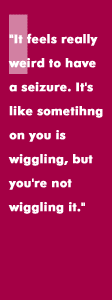 Beating
a brain tumor "If someone says I don't have a brain," Franklyn joked, " I can tell them I do, too, and I have pictures to prove it." The family's medical drama began uneventfully enough in 1999. Franklyn had been complaining of nausea, but his mother figured he'd been hit by a nasty flu bug that had been going around the base. "Who thinks of a brain tumor when your son is nauseous?" she asked. Nausea and dizziness, she would learn later, are more common symptoms of brain tumors in children than seizures. Then one night in May, Mandy Barber took the family bowling. Franklyn mentioned that his right arm and right leg felt numb. Mandy attributed it to the cramped position Franklyn sat in during the car ride. No problem. "Before this happened, he was a totally normal kid," said Mandy. "He didn't have so much as an allergy." But later that evening, Franklyn started smacking his lips and staring off into space. Franklyn was having the first of several epileptic seizures, uncontrolled storms of electricity pulsing through his brain. "He wasn't all there in the eyes," recalled Mandy. "It wasn't like in the movies; he didn't fall down and writhe." "It feels really weird to have a seizure," added Franklyn. "It's like something on you is wiggling, but you're not wiggling it."
Home |
Table of Contents |
To our Readers |
Building on Basics UC Davis Health System | © 2000, 2001, 2002 UC Regents. All rights reserved. |
 |
